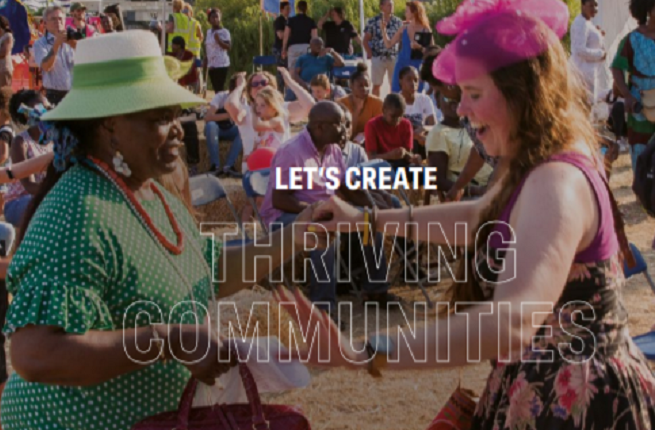Blog: response to the ACE Strategy 2020-30

After nearly two years of evidence-gathering and consultation, Arts Council England (ACE) has published its much-awaited 10-year Strategy, ‘Let’s Create’. The Arts Council itself would admit that it has been far from an easy process, but the intensity with which it has engaged with the public and arts organisations is reflected in the quality of the end result.
So, what does the Strategy say? And what will it mean for arts organisations? In this blog I explain how the Strategy resonates with our own work on the Civic Role and why ACE’s vision for the decade is so important – and not just for the arts and culture sector.
Promoting the Civic Role
The Foundation’s work on the Civic Role was influenced by my deep sense that access and participation in the arts were not enough. Our Participatory Performing Arts strand had sought to widen participation in the performing arts to people from all walks of life. However, issues of diversity and education continued to be narrowly and separately framed by many arts organisations.
“Our work on the civic role came from my deep sense that access and participation in the arts were not enough.”
It was clear that a more holistic and democratic approach was needed, which shifted the emphasis from participation to co-creation. And so, in 2016 The Inquiry into the Civic Role of Arts Organisations was born, dedicated to exploring how arts organisations could better fulfil their civic role. Consultation with the sector helped us identify key levers for change, and Phase Two of our work is now seeking to embed ‘the civic’ into arts organisations, funding and policy.
The ACE Strategy: ‘Let’s Create’
‘Let’s Create’ signals a welcome and significant shift for arts and culture in England, in line with the growing movement of organisations that has been considering arts and civic society in recent years. The Strategy centres around three outcomes: creative people; cultural communities; and a creative and cultural country.
Here are my three main reflections on ACE’s ‘route-map’ for the next decade:
Power to the people
A core belief of our Civic Role programme is that publicly funded institutions must articulate more clearly the value they bring to their communities and wider society. For the first time, the Arts Council has made a clear statement that it exists to serve the public which funds it (with taxpayers’ money and lottery money) by placing them at the heart of the Strategy.
It sets out a vision for 2030 where everyone can access opportunities to be creative and experience high-quality culture. At the Foundation, we have long championed the view that arts and culture enrich the lives of individuals and help create stronger communities. I was extremely pleased to see the promotion of everyday creativity and a broader definition of culture included in this Strategy.
Relevance, relevance, relevance…
As Maria Balshaw, Director of Tate Modern, noted in our collection of essays What Would Joan Littlewood Say? “Fulfilling our civic responsibility makes us relevant as arts institutions.”
This view that arts organisations should be relevant is not new. In fact, research carried out during our Inquiry Phase revealed that the civic role has a long history, gradually shifting from widening access, to education and community projects, to today’s focus on engaging communities in creating content that reflects social, environmental and economic issues.
“As we face the challenges and opportunities of the next decade, arts and culture have an important role to play.”
ACE’s new Strategy contextualises arts and culture – emphasising how it can help society respond to a range of contemporary challenges, such as social cohesion and climate breakdown; grow local economies; and improve health and wellbeing.
In the pursuit of relevance, many arts organisations are reimagining how they operate in exciting ways, from co-creation and cross-sector partnerships, transforming how their buildings are used, and engaging with the issues that matter most to their communities. As we face the challenges and opportunities of the next decade, arts and culture have an important role to play.
Arts for art’s sake?
When ACE published its draft strategy late last year, its suggestion that arts organisations should prioritise relevance triggered a wave of criticism. The Stage reported that ‘Relevance not excellence will be new litmus test for funding’, while an article in The Times stated, ‘Appealing to the majority is no way to make great art’. The fundamental purpose of the arts – as an instrument for social change or art for art’s sake – continues to be a contentious topic.
“The belief that relevance and excellence do not need to be in competition has been at the heart of our work.”
But relevance and excellence do not need to be in opposition. Indeed, this belief has been at the heart of our work on the Civic Role. Responding to the backlash, ACE CEO, Darren Henley clarified that engagement and excellence “can and should complement each other”. Our bank of 80 international case studies is testament to this, profiling arts organisations that are committed to playing a civic role while maintaining the highest ambitions and artistic standards. I hope that the ACE Strategy will go some way to dismantling this unhelpful binary about the arts’ social or intrinsic value.
Looking to the future
So, what role will arts organisations play in ten years’ time? It is my hope that arts and cultural spaces will belong to and reflect their communities, with communities at the centre of artistic practice and the arts at the centre of civic life. I applaud the Arts Council for setting out this bold vision for the future, which recognises the transformative potential of arts and culture for everyone in society.
Andrew Barnett, Director, Calouste Gulbenkian Foundation (UK Branch)
